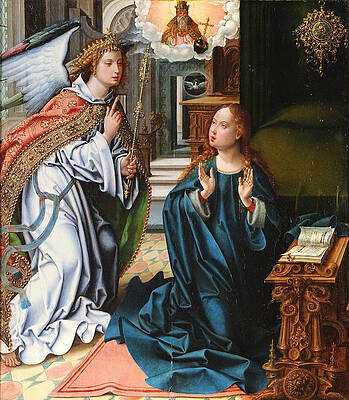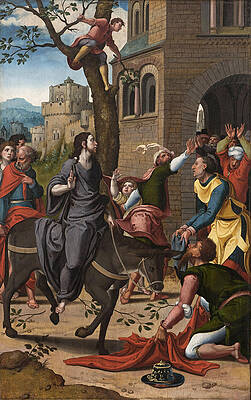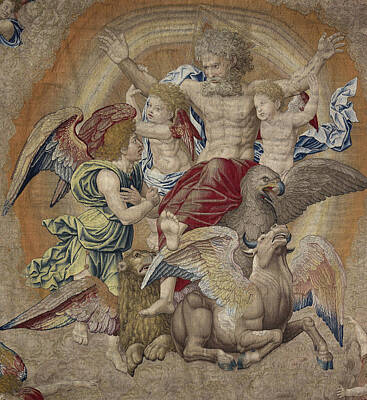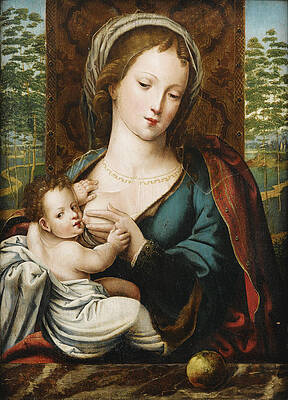Pieter Coecke van Aelst
Paintings
Eleven worshipers with St James the Greater
Entry into Jerusalem
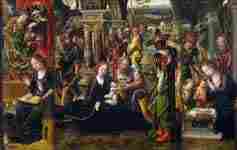
Triptych - The Annunciation, Adoration of the Magi, Adoration of the Shepherds

Four praying with John the Evangelist
Drawings
God The Father With The Symbols Of The Fourth Apostles Tetramorphos Know As The Trinity
Workshop of Pieter Coecke van Aelst
The Virgin and Child
The Last Supper
Pieter Coecke van Aelst or Pieter Coecke van Aelst the Elder (August 14, 1502 – December 6, 1550) was a Flemish painter, sculptor, architect and a designer of woodcuts, stained glass and tapestries. His principal subjects are Christian religious themes. He worked in Antwerp and Brussels and was court painter to Charles V, Holy Roman Emperor.
Life
He was the son of the Deputy Mayor of Aalst. The early Flemish biographer Karel van Mander reports in his Schilder-boeck published in 1604 that Pieter Coecke studied under Bernaert van Orley, a leading Flemish Renaissance painter. There are no documents that prove this apprenticeship but there are strong stylistic similarities between the styles of the two artists.[1]
Saint Luke paints the Virgin
Pieter Coecke later studied in Italy before entering the Antwerp Guild of Saint Luke in 1527. In 1533, he travelled to Constantinople for one year in an attempt to persuade the Turkish sultan to give him tapestry commissions.[2] This mission was, however, not successful.[1]
Pieter Coecke established a studio in Brussels in 1544 or 1546. In Brussels he realized paintings and produced ontwerpen (small-scale drawings)[3] and full-scale cartoons for tapestries.[4]
Pieter Coecke married twice, first to Anna van Dornicke (d 1529). His first wife was the daughter of the Antwerp painter Jan Mertens van Dornicke, one of the most successful painters working in Antwerp.[5] His father in law may have been his teacher. There were two children from his first marriage, Michel van Coecke and Pieter van Coecke II. The latter was a painter.[1] After de death of his first wife he had an affair with Anthonette van der Sandt, whom he never married but with whom he had a daughter, Antonette, and at least one son, Pauwel.[5] He later married Mayken Verhulst( 1518-1599 ), who was a painter of miniatures and the mother of three children, a son named Pauwel (even though he had another son with this name), and two daughters called Katelijne and Maria.[1] The prominent painter Pieter Brueghel the Elder married van Aelst's daughter Maria (called 'Mayken'). Karel van Mander stated that Pieter Coecke's second wife was the first teacher of her grandchildren, Pieter Brueghel the Younger and Jan Brueghel the Elder.
He was appointed court painter to Charles V a few months before his death. His students included leading painters such as Gillis van Coninxloo, Willem Key, Hans Vredeman de Vries, Michiel Coxcie, and Pieter Brueghel the Elder.
Work
Pieter Coecke van Aelst was a versatile artist who was a master designer and devised projects across various media, from tapestry series, to panel paintings, prints, stained glass, and goldsmith's work.[6]
His Last Supper was one of the most popular images of the sixteenth century. It was freely inspired by Leonardo da Vinci's Last Supper in Milan and Marcantonio Raimondi's engraving after Raphael's drawing of the same subject. The gestures of the apostles are based on a print by Albrecht Dürer of 1523. There exist about 45 versions of this composition, which were executed with the assistance of workshop assistants. A great number of the versions are dated, and 6 or 7 date to 1528. The Last Supper probably originated as a drawn model, which was then transferred to a panel by means of cartoons. The composition could be ordered in two formats: 50 x 60 cm and 60 x 80 cm. The large format appears to have been the most popular. Small biblical scenes are depicted in the background, heightening the impact of the main theme. Through the window an Antwerp archway we can see the Entry in Jerusalem of Jesus Christ. Depictions of the Fall of Man are visible in the ornamented window. The medals represent the stories of David and Goliath and the Slaying of Cain. The scene with Cain and Abel is taken directly from a print by another popular Renaissance artist, Jan Gossaert. The whole iconography accentuates the Christian occupation with original sin and mankind's salvation through Christ's sacrifice.[7]
St. Jerome in his study
Another popular work was the composition St. Jerome in his study of which Pieter Coecke and his workshop produced multiple versions. Saint Jerome is revered by Christians for his translation into Latin of the Bible, which he completed it in a monastery in Palestine. In the version of the subject in the Walters Museum Pieter Coecke suggests the Oriental setting by the view through the window which shows camels in a landscape. To the wall is affixed an admonitation, "Cogita Mori" (Think upon death), a vanitas motif that is reiterated by the skull. The saint's Bible is opened to an image of the Last Judgment, while the hourglass and candle are further reminders of the passage of time and the imminence of death.[8] Another version of this subject was sold at Christie's (28 January 2015, New York, lot 104 , $665.000 ) and reprises similar iconographic elements to stress the transience of human life and the importance of the sacrifice of Christ for people to find salvation when the Last Judgement comes.[9] for
Pieter Coecke was well known for its graphic works and publications. He made drawings for a series of woodcuts on the Customs and Fashions of the Turks. They were published posthumously in 1553 by Mayken Verhulst. He was also the publisher and designer of a volume of prints entitled De seer wonderlijke…Triumphelijke Incompst van … Prince Philips commemorating the 1549 Joyous entry into Antwerp of Prince Philip (later Philip II).[1]
Pieter Coecke was renowned for his tapestry designs which were executed by the Brussels tapestry workshops. The patrons for the tapestries included Emperor Charles V, Francis I of France, Henry VIII of England and Cosimo de' Medici.[6] He built a reputation as a tapestry designer with his popular series of the Seven Deadly Sins,Joshua and Julius Caesar. In 1550, Mary of Hungary, the governor of the Netherlands, appealed to van Aelst to assist with Jan Cornelisz. Vermeyen's Conquest of Tunis tapestry series but he died before it could be completed.[5]
Pieter Coecke was a gifted linguist and is noted for his translation of Vitruvius' De architectura into Flemish and of Sebastiano Serlio's architectural treatise, Architettura (1539) into High German, Flemish and French. The translations played a crucial role in spreading Renaissance ideas to the Low Countries and hastening the transition from the late Gothic style prevalent in the area at the time.[1]
Selected works[10]
Detail of Eve, from God Accuses Adam and Eve after the Fall, tapestry
Christ and His Disciples on Their Way to Emmaus, Oil on panel, 68 x 87 cm, Private collection [1]
Descent from the Cross, c. 1535, Oil on panel, 119 x 170 cm, Amstelkring Museum, Amsterdam [2]
Holy Trinity, Oil on panel, 98 x 84 cm, Museo del Prado, Madrid [3]
Crucifixion, tapestry, Pinacoteca Comunale, Forlì[4]
Triptych, 1530s, Oil on panel, 105 x 68 cm (central), 105 x 28 cm (each wing), Private collection [5]
Triptych: Adoration of the Magi, Oil on panel, 89 x 57 cm (central), 89 x 25 cm (each wing), Private collection [6]
Triptych: Descent from the Cross, 1540–1550, Oil on panel, 262 x 172 cm (central), 274 x 84 cm (each wing), Museu Nacional de Arte Antiga, Lisbon [7]
Triptych of Saint James the Lesser and Saint Philip, Museu de Arte Sacra do Funchal
The last Holy Communion, Kroměříž Archbishop's Palace picture gallery, Kroměříž [11]
References
Jane Campbell Hutchison. "Coecke van Aelst Pieter, I." Grove Art Online. Oxford Art Online. Oxford University Press. Web. 8 Dec. 2014
A. Wunder. "Western Travelers, Eastern Antiquities, and the Image of the Turk in Early Modern Europe" Journal of Early Modern History, 7 (2003).
Edith A. Standen, "Some Sixteenth-Century Flemish Tapestries Related to Raphael's Workshop", in: Metropolitan Museum Journal (1971).
R. Bauer, ed. Tapisserien der Renaissance: Nach Entwürfen von Pieter Coecke van Aelst, exhibition catalogue, Schloss Halbturn, 1981; I. Buchanan. "Designers, Weavers and Entrepreneurs: Sixteenth-Century Flemish Tapestries in the Patrimonio Nacional" The Burlington Magazine, (1992)
Getting to Know Pieter Coecke van Aelst at the Metropolitan Museum
Grand Design, Pieter Coecke van Aelst and Renaissance Tapestry at the Metropolitan Museum of Art
Pieter Coecke van Aelst, The Last Supper, at Christie's
St. Jerome in his study at the Walters Museum
Pieter Coecke van Aelst I, Saint Jerome in his study at Christie's
Web Gallery of Art: Pieter van Aelst
Picture gallery Kroměříž, Catalogue of the collection of Archbishops' Castle in Kroměříž paintings, 1998, Editor: Milan Togner, 520 pages, ISBN 80-238-2362-0 (Czech)
Pieter Coecke Van Aelst: Drawings & Paintings (Annotated) by Raya Yotova (Author) Format: Kindle Edition
---
Fine Art Prints | Greeting Cards | Phone Cases | Lifestyle | Face Masks | Men's , Women' Apparel | Home Decor | jigsaw puzzles | Notebooks | Tapestries | ...
---
Artist
A - B - C - D - E - F - G - H - I - J - K - L - M -
N - O - P - Q - R - S - T - U - V - W - X - Y - Z
Retrieved from "http://en.wikipedia.org/"
All text is available under the terms of the GNU Free Documentation License


